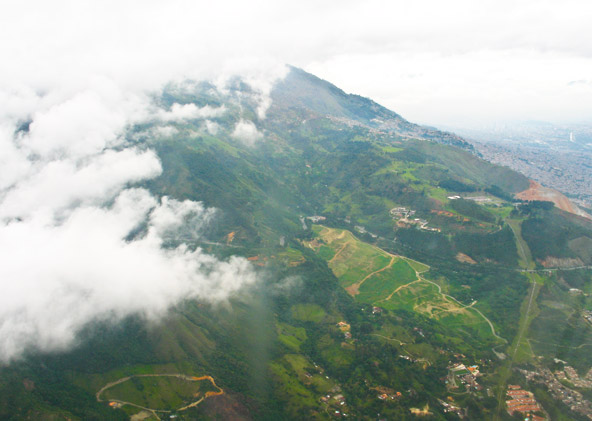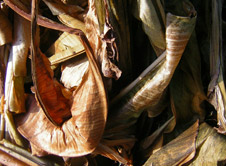
June 2007, Andes mountains, Northern Colombia.
Photo: Phillip Robertson
Our flight from Bogotá to Apartadó headed north along the great verdant spine of the Andes. Flying over Medellín, a city of brick high-rises surrounded by mountains, you can look down into the cocaine mansions and see if there is anyone in the pool. All of the country's cities have growing slums on their peripheries filled with war-displaced peasants and the dispossessed looking for work. Neighborhoods of rough shacks with corrugated metal roofs on red dirt roads, lit with a single bulb; the inhabitants of the poor barrios are the refugees from a war that has lasted more than forty years. White veils of clouds drifted over the ridges, as we landed in Medellín, then took off again a few minutes later for Apartadó. From the air you want to buy a parcel, you want to get in on all that beauty. We flew down out of the cool air of the Andes toward an airport which was nothing more than a few lines of asphalt cut out of the bright green banana plantations. The plane touches down and we are in the belly of the organism but we do not know it yet.
When the beat up taxi pulled away from the airport onto the shaded road, the air pouring through the windows was rich with the smell of wet earth and rotting leaves. Black men walked slowly through the fields with machetes. Most are the descendants of African slaves, and they still get the jobs that keep a man out in the sun. Spanish colonists brought their ancestors here and worked them until they simply gave out.
Today, the banana region exports hundreds of millions of dollars of bananas and plantains, but the workers at the bottom of the export pyramid have little to show for it. They live in the slums at the edge of town like barrio Obrero where paramilitary groups targeted them in the late nineties and murdered them in their homes. During this time of extreme militarization in Urabá, anyone suspected of labor activism or the sympathy with the leftist rebels was at risk of being assassinated. The Colombian military let the gunmen work without interruption. "We patrolled side by side, fighting the guerillas," a former paramilitary fighter told me over beers a few days after we arrived in town. "Sometimes we traded with the Army. We gave them hostages in exchange for ammunition." Paracos-as the paramilitaries are known-would come for their victims on motorcycles with their hair cut short like a soldier's. They called it grabbing someone. It didn't matter what you said to them, when the paracos grabbed someone that person always died, and it was always the Autodefensas Unidas de Colombia (AUC) that did the grabbing.
As the taxi clattered out of the green labyrinth and into Apartadó, there was no welcome sign, but were there one it should read, "Founded by United Fruit, 1963. Before us, there was nothing. Population X." Apartadó was just a small village before the company arrived and likewise Turbo to the east. The banana growing region was a marshy stretch of coast near Panama with a few indigenous people and that was all. Then United Fruit, one of the most powerful companies in the history of the Americas, transformed this section of Colombia, remade it in its own protean image and then left it behind.
Americans did not always eat bananas. In fact, the tropical staple only came to the nation's table through an act of desperation by a Brooklyn railroad speculator named Minor Keith. In 1871, Keith went into business with his uncle, Henry Meiggs, to build a railway from the Costa Rican capital San José to the port city of Limón. It was, by all accounts, a miserable undertaking. Italian workers mutinied over the conditions and inmates from Louisiana prisons were brought in when no one else would do the job. Most of them died-as many as five thousand-trying to complete Meiggs and Keith's project, an enterprise that was already unpopular and strangled by debt when it finally reached completion in 1890.
Not longer after the railway began operations, it quickly demonstrated itself to be a losing proposition for passenger transport, but Keith wasn't ready to give up. During the construction of the railway, he had started planting banana groves on government-ceded land near the tracks to feed his workers, so he decided to try his hand at the export business. He moved his track-side bananas to the port at Limón for free-since he already owned the train-and freighters sailed with the fruit to the United States where Keith sold it for a hefty profit. Soon, his banana gamble was worth more than the railroad. In 1899, on the eve of the twentieth century, Minor Keith merged his United Fruit with Boston Fruit, famous for its giant fleet of white ships, and "the octopus"-as the company is known among Latin American journalists-was born.
Soon its tentacles reached into the governments of Guatemala, Honduras, Panama, and Costa Rica, and manipulated the political establishment whenever its interests were threatened. And the company, with its acquisitive genius, kept branching out into new enterprises whenever the need arose. In 1901, United Fruit took over the postal system in Guatemala, and in a number of other countries it controlled the railway systems and the telegraph lines. A CIA-engineered coup codenamed Operation PBSUCCESS overthrew Guatemala's elected president in 1954, when United Fruit's business interests were threatened by new land reform laws. The company wielded unprecedented power in Latin America, growing into a transnational entity whose appetite for resources drove the politics of the entire region.
By the twenties, United Fruit also had transformed small villages like Santa Marta, along Colombia's Caribbean coast, into booming industrial centers. Workers flooded into Santa Marta from distant places at a time when paying jobs were scarce. By the decade's end, however, newly elected Liberal representatives and labor leaders criticized the company and the tax-free export deal it had brokered with the government. In 1928 workers went on strike, paralyzing the company. In response, the right-wing government of Miguel Abadía Mendez called out the army, which promptly sealed off the streets to a plaza full of assembled civilians in Ciénaga and opened fire. It was a massacre that Gabriel García Márquez would immortalize in One Hundred Years of Solitude.
 LEAD IMAGE: Dried banana leaves.
LEAD IMAGE: Dried banana leaves.Photo: Unknown
To contribute or commission a new Colombia reporting project, click here.
© Phillip Robertson, 2009-2014.
